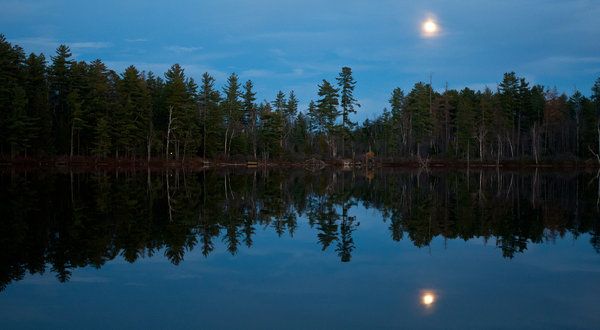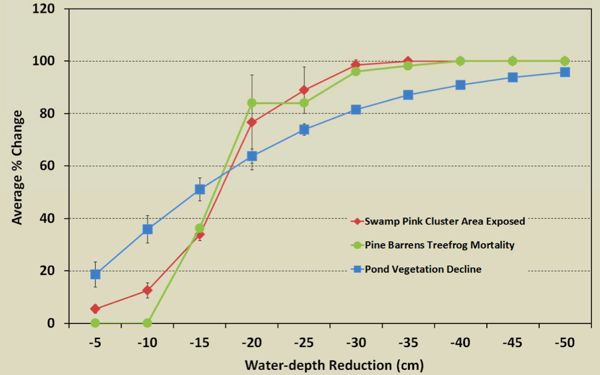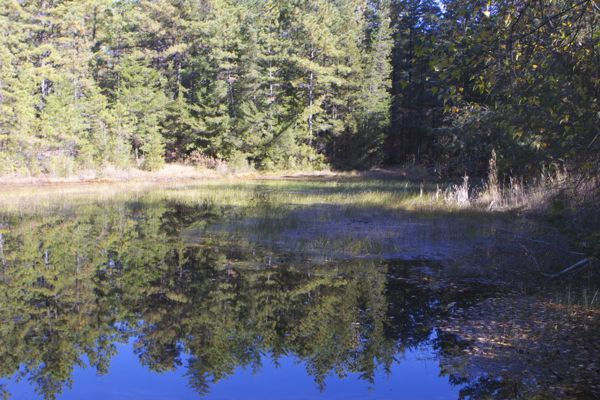Pinelands Ecosystems Highly Sensitive to Water Levels – Climate Change Will Alter Hydrology
“American Die”

Osgood Pond near Paul Smiths, N.Y - Adirondack spruce forests and bogs will be destroyed as climate and growing season become like Georgia due to global warming. Credit Ruth Fremson, NY Times I can't remember if I cried, when I read about his widowed bride.
I can’t remember if I cried, when I read about his widowed bride.
But something touched me deep inside, the day, the music, died. ~~~ American Pie –(Don Mclean 1971)
Don McLean couldn’t remember, but I recall that I cried when I read about the NY Times story Savoring Bogs and Moose, Fearing They’ll Vanish as the Adirondacks Warm .
That article reported on science conducted by NY DEC and Cornell University, which projected the decline and eventual loss of spruce-fir forests and alpine tundra in the Adirondacks as a result of climate change.
Mr. Jenkins, who is the author of the book “Climate Change in the Adirondacks: The Path to Sustainability,”spends much of his time on the water and in the woods, documenting the ecosystem with a notebook and a camera. He thus brings an unusual perspective to the scene. Where a casual observer might behold diversity and continuity, he projects decades into the future and finds absence and loss.
“Nothing we see here is found at temperatures 10 degrees warmer, and very little makes it to five degrees warmer,” Mr. Jenkins said matter-of-factly on a mild fall day. “We will be in a climate that this community has never known in its history. One has to go back to world climate levels we haven’t seen in 15 million years.” …
A major study of the impact of climate change on New York State drew similar conclusions. In a 600-page report published last month, scientists from Cornell and Columbia Universities, as well as the City University of New York, said that temperatures would rise as much as nine degrees by the 2080s. They also projected the decline and eventual loss of spruce-fir forests and alpine tundra in the Adirondacks.
Mr. Jenkins has yet to detect signs of stress in trees and plants, which respond slowly to alterations in temperature. Northern mammals like moose and pine martens are holding steady, though they, too, are sure to suffer. “They are both at their thermal limits here,” he said.
Yet there is ample evidence elsewhere that the region is already reacting to a warmer climate. “For the hunters, farmers, hikers and birders, the change in the climate, especially in the past 10 to 15 years, is just too great to write off,” he said
Repeat: loss of the spruce-fir forests. Gone. Forever.
Growing up, my family vacationed in the Adirondacks. The pristine lakes and streams and wild forests just rocked my young world.
The thought that those forests would be gone forever – that my grandchildren and all boys and girls might never again experience what I did – forever – is just too depressing for words. From awe to despair.
I don’t have that emotional attachment to the Pinelands – but I’m sure many do – and that they would share my feelings too.
So, what about the Pinelands? What will climate change do to the Pinelands?
Yesterday, I wrote about current impacts to forests from warming and insects (see: Climate change already impacting Pinelands forests).
But in addition to temperature driven insect threats, Pinelands scientists have done considerable research on how water levels impact Pinelands ecology.
While this research was originally intended to assess water withdrawals, much of this work is relevant to assessing the hydrological impacts of climate change, because fundamental science and climate models project that climate change will alter temperature, rainfall, and drought patterns that drive Pinelands water levels and ecosystem dynamics:
Physiological Indicators
In plants, stress due to marginal-growth conditions associated with altered hydrologic regimes may be reflected by physiological responses long before death or obvious growth reductions become apparent. Because many of the indicator-plant species to be studied are woody shrubs, their response to alterations in water regime may be slow. It can be expected that wetland-adapted plants will experience drought stress if subjected to hydrologic conditions that are optimal for upland plants. Moreover, differences in tolerance to both dry soils and wet soils may eventually drive changes in community composition. Physiological measurements can serve as an indicator of the stresses that may eventually lead to changes in community composition.
Landscape Models
The models developed as part of the species, community, and ecosystem-process field studies will be translated into GIS-based models that will be used to estimate the effects of hydrologic changes across the landscape of the study areas. The GIS-based species and community gradient models will be used to assess the landscape-scale distribution of community types and individual species and their response to changes in hydrologic regime. The ecosystem-process landscape models will be used to estimate water stress and photosynthesis under different hydrologic-regime scenarios. The goal is to develop models that can be applied throughout the Pinelands area.
Anuran-larval Development
Intermittent ponds are important breeding habitat for many native Pinelands frog and toad species, including Pine Barrens treefrogs, northern spring peepers, and southern leopard frogs. The successful recruitment of these species depends on the maintenance of adequate water levels for larval development. Altered hydrology may have a more pronounced effect on late-breeding species such as the Pine Barrens treefrog because their transformation from larvae to adults occurs closer to the period when ponds usually dry. The central question to be addressed by the anuran research conducted by Pinelands Commission scientists is how larval development is related to intermittent-pond hydrology.
Pinelands Commission scientists have done lots of research that shows that Pinelands ecosystems are very sensitive to water –
Now they need to apply that science to climate change induced hydrological modification – not just water withdrawals.
[Note: tree frog:(Fla)
The impending global climate change may be a threat to the Pine Barrens treefrog due to predicted longer drought periods, more severe storms and floods, less available fresh water, increasing temperatures, and sea level rise (Field et al. 2007).
So when political hacks at the Commission and DEP say that they don’t have the tools to consider climate change in reviewing proposals to build massive fossil fuel infrastructure like the South Jersey Gas Co. pipeline, call them out on that.
Check it out:
Final Reports and Publications
Reports:
Bunnell, J. F. and J. L. Ciraolo. 2010. The potential impact of simulated groundwater withdrawals on the oviposition, larval development, and metamorphosis of pond-breeding frogs. Pinelands Commission, New Lisbon, New Jersey, USA. (click here)
Ehrenfeld, J. G., and S. Yu. 2010. Nitrogen dynamics study final report. Part II. Dynamics of nitrogen under field conditions. Rutgers University, New Brunswick, New Jersey, USA. (click here)
Laidig, K. J. 2010. The potential impact of simulated water-level reductions on intermittent-pond vegetation. Pinelands Commission, New Lisbon, New Jersey, USA. (click here)
Laidig, K. J., R. A. Zampella, A. M. Brown, and N. A. Procopio. 2010. Development of vegetation models to predict the potential effect of groundwater withdrawals on forested wetlands. Pinelands Commission, New Lisbon, New Jersey, USA. (click here)
Laidig, K. J., R. A. Zampella, and C. Popolizio. 2010. Hydrologic regimes associated with Helonias bullata L. (swamp pink) and the potential impact of simulated water-level reductions. Pinelands Commission, New Lisbon, New Jersey, USA. (click here)
Lathrop, R. G., Y. Zhang, Z. Maio, and J. Bognar. 2010. Landscape level modeling of the potential effect of groundwater-level declines on forested wetlands in the New Jersey Pinelands. Rutgers University, New Brunswick, New Jersey, USA. (click here)
Procopio, N. A. 2010. The effect of streamflow reductions on aquatic habitat availability and fish and macroinvertebrate assemblages in coastal plain streams. Pinelands Commission, New Lisbon, New Jersey, USA. (click here)
Publications:
Bunnell, J. F. and J. L. Ciraolo. 2010. The potential impact of simulated ground-water withdrawals on the oviposition, larval development, and metamorphosis of pond-breeding frogs. Wetlands Ecology and Management 18:495-509. (click here)
Charles, E. G. and R. S. Nicholson. 2012. Simulation of groundwater flow and hydrologic effects of groundwater withdrawals from the Kirkwood-Cohansey aquifer system in the Pinelands of southern New Jersey. U.S. Geological Survey Scientific Investigations Report 2012-5122, 219 p. (click here)
Ehrenfeld, J.G. and S. Yu. 2012. Patterns of nitrogen mineralization in wetlands of the New Jersey Pinelands along a shallow water table gradient. American Midland Naturalist 167:322-335. (click here)
Kennen, J. G. and M. L. Riskin. 2010. Evaluating effects of potential changes in streamflow regime on fish and aquatic-invertebrate assemblages in the New Jersey Pinelands: U.S. Geological Survey Scientific Investigations Report 2010-5079, 34 p. (click here)
Laidig, K. J. 2012. Simulating the effect of groundwater withdrawals on intermittent-pond vegetation communities. Ecohydrology 5:841-852. (click here)
Laidig, K. J., R. A. Zampella, and C. Popolizio. 2009. Hydrologic regimes associated with Helonias bullata L. (swamp pink) and the potential impact of simulated water-level reductions. Journal of the Torrey Botanical Society 136:221-232. (click here)
Laidig, K. J., R. A. Zampella, A. M. Brown, and N. A. Procopio. 2010. Development of vegetation models to predict the potential effect of groundwater withdrawals on forested wetlands. Wetlands 30:489-500. (click here)
Procopio, N. A. 2012. The effect of streamflow reductions on aquatic habitat availability and fish and macroinvertebrate assemblages in coastal plain streams. Ecohydrology 5:306-315.
Sumner, D. M., R. S. Nicholson, and K. L. Clark. 2012. Measurement and simulation of evapotranspiration at a wetland site in the New Jersey Pinelands. U.S. Geological Survey Scientific Investigations Report 2012-5118, 30 p. (click here)
Walker, R. L., P. A. Reilly, and K. M. Watson. 2008. Hydrogeologic framework in three drainage basins in the New Jersey Pinelands, 2004-06: U.S. Geological Survey Scientific Investigations Report 2008-5061, 147 p. (click here)
Walker, Richard L., R. S. Nicholson, and D. A. Storck. 2011. Hydrologic Assessment of Three Drainage Basins in the Pinelands of Southern New Jersey, 2004-06. U.S. Geological Survey Scientific Investigations Report 2011-5056, 145 p. (click here)
Yu, S. and J. G. Ehrenfeld. 2009. The effects of changes in soil moisture on nitrogen cycling in acid wetland types of the New Jersey Pinelands (USA). Soil Biology and Biochemistry 41:2394-2405. (click here)
Zhang, Y., Z. Miao, J. Bognar, and R. G. Lathrop Jr. 2011. Landscape scale modeling of the potential effect of groundwater-level declines on forested wetlands in the New Jersey Pinelands. Wetlands 31:1131-1142.





Pingback: wowgoldreviews
Pingback: Quantum Vision System Review
Pingback: cheap mac cosmetics online
Pingback: fitflop salg
Pingback: diablo 3 gold guide
Pingback: ffxiv realm reborn
Pingback: Roger Vivier flats
Pingback: safest wow gold
Pingback: www.epsilog.com/forum/fitflop.php
Pingback: roger vivier sale
Pingback: like it
Pingback: WolfeNotes.com » The Pinelands Commission Is Finally About To Take A First Baby Step On Climate Policy